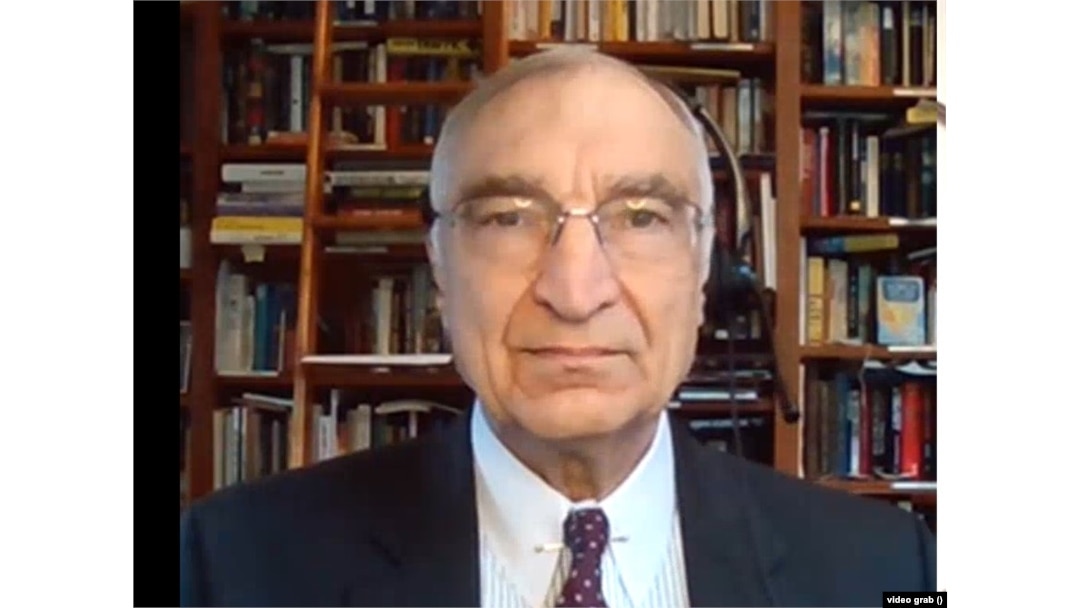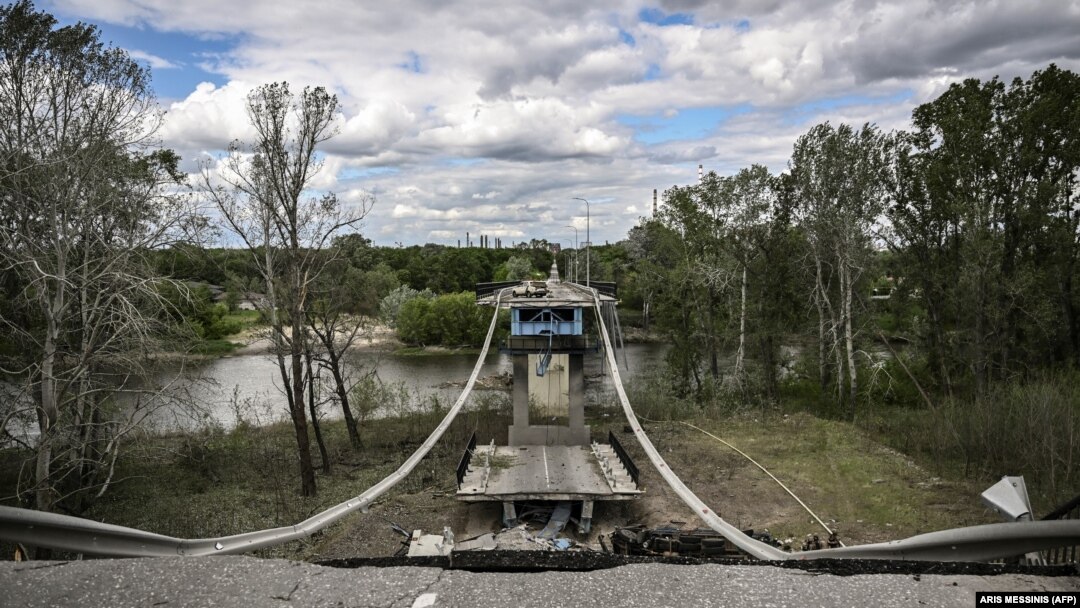Russian troops are in the midst of an attack on two cities straddling a river in eastern Ukraine that is designed to encircle Ukrainian forces in what could be a decisive battle for Moscow’s military campaign in the country.
The city of Syevyerodonetsk -- which sits on the easternmost part of Ukrainian-held territory in the Donbas -- and its twin Lysychansk, which lies across the Siverskyi Donets River, are at the heart of a pivotal assault that has Russian forces advancing from three directions as they try to encircle Ukrainian troops on the eastern front.
The effort to trap Ukrainian forces could have major repercussions for the current phase of the war and could determine the success or failure of Moscow’s revised plans of seizing full-control of the Donetsk and Luhansk provinces. The Russian troops continue to make small advances but are yet to break through, with Ukrainian President Volodymyr Zelenskiy warning of difficult weeks ahead.
The intense fighting in the Donbas comes after more than three months of war that many experts and Western officials originally predicted would see Russia win within days or weeks.
Moscow has achieved only limited gains in a war where it is reported to have suffered heavy military losses since first invading Ukraine on February 24. Ukraine has also sustained major combat casualties and many of its cities have been reduced to rubble, with thousands of citizens killed and wounded.
To find out more about the changing battlefield, RFE/RL spoke with Mark Cancian, a retired U.S. Marine colonel and senior adviser at Washington's Center for Strategic and International Studies.
RFE/RL: Russia has stepped up its attacks in the east and poured more forces and equipment into the campaign, especially around Syevyerodonetsk and Lysychansk, where it is trying to encircle Ukrainian forces. What do you make of these developments and does this show that Russia has some momentum on its side in the Donbas?

Mark Cancian
Mark Cancian: It's important to put this in perspective. This is [essentially] the third step in the Russian war aims and the reduction of those war aims. In the very beginning, they were trying to capture Kyiv and take control over the entire country, which, of course, failed. In their second effort, they moved their forces east and they tried to bite off most of the eastern Donbas region. They tried to strike south from Izyum and then move north from Mariupol, but that failed, too.
The Russians have not made any significant progress in two or three weeks. Mariupol held out much longer than anyone expected, and it took a long time for the Russians to get those forces [from Mariupol] freed up, and they also took a lot of casualties.
So that southern prong Russia had planned for never really materialized. Now, the focus is on Syevyerodonetsk, which is a much smaller pocket. The Russians are [pushing] to surround the city -- they made an attack from the north and tried to cross a river [but] did it very badly and lost a lot of troops and equipment in the process.
But they're still trying to pinch off that area. That city would give them a great deal of control over most of Luhansk Province. That may be their last ambition in this war because they've [taken] a lot of casualties. [Russian forces] are clearly running out of steam and their morale has always been shaky. I doubt that they have the combat power to do much more than that.
RFE/RL: Many analysts have suggested that it appears that Russian forces have abandoned efforts to encircle the large Ukrainian formations in eastern Ukraine and are instead attempting to secure smaller encirclements of Ukrainian troops in the Donbas. Are there downsides and risks for Russia in this change in approach?
Cancian: Well, the smaller encirclement is probably all they have the combat power to execute, given that the attempt at the larger one failed.
It's important to keep in mind that the Russians just don't have a lot of combat power; in fact, they never have throughout the entire campaign. They began with maybe 200,000 troops, but of those maybe 30,000 or so were [separatist] militias from the Donbas provinces. So maybe they had 150,000 ground forces or so, but that's not very much for the massive amount of territory that we're talking about for the initial attack they did on four different axes.
To put it in context, the front lines now are about where the front lines were in early 1943 [during World War II between the Soviet Union and Nazi Germany]. At that time, the Soviets had well over a million soldiers on the same front line, where the Russians now have 150,000 or maybe fewer troops.
A man sits next to his horse during mortar shelling in Syevyerodonetsk on May 18.
So they just don't have very much combat power given the task ahead. That's why when the attacks on Izyum failed, they needed to further constrain what they were trying to do. The notion of an encirclement [is] an [established] part of Russian military doctrine, and [it] is something that they did in the Second World War.
The nature of the battlefield lends itself to trying that against the Ukrainian forces, with them sticking out to the east like how they’ve been positioned. It's a sensible thing to try from a strategic perspective. The problem is that it's not clear that [Russia] has the kind of power to do it.
RFE/RL: Senior Kremlin officials are increasingly openly admitting that the Russian offensive in Ukraine is moving slower than anticipated and new equipment and aid continue to be sent from Western nations to Ukraine. With those developments in mind, in your view, how do the two militaries stack up against each other currently after more than three full months of war?
Cancian: Over time, the Ukrainians are getting stronger and the Russians are getting weaker. The Ukrainians are benefiting from the flow of munitions and weapons that are coming from the West, which has made a huge difference. They would not have been able to sustain their resistance to this point without that flow of equipment and munitions.
A Ukrainian soldier takes cover during Russian shelling outside the city of Lysychansk on May 23.
There are now some questions about how much the Ukrainians can actually absorb. But those weapons will both replace what they've lost and increase their capabilities in certain important ways, so they're getting stronger. It's also important to note that at the beginning of the war the Ukrainians called up a lot of reservists and created these militias that were initially quite untrained and unskilled, but after three months they're getting much better trained and much savvier on the battlefield. So I think that their forces are also becoming more effective.
On the other side, the Russians are getting less effective. They've taken a lot of casualties. Certainly, more than the Ukrainians, although it's a little unclear exactly how many casualties the Ukrainians have taken.
The Russians have replaced many of those casualties, but they replaced them with lower quality units and some individual replacements. They've used a lot of their preferred munitions and their missile stockpile in particular appears to be low. Notice that in the last couple of weeks, they really haven't fired too many missiles. I think that's because they're running low.
RFE/RL: There have been growing warnings, as well as U.S. and British intelligence showing, that a Russian naval blockade is halting Ukrainian ports in what many world leaders are calling a deliberate attack on the global food supply chain by Moscow. Does this mean we’re likely to see more battles and military attention focused at sea than we have so far?
Cancian: I think we will. There's no question that the Russians have instituted a naval blockade of the Ukrainian ports, and that's pretty standard in this kind of situation. It does have an effect on world food markets [and] it also affects Ukrainian imports, which makes it much more difficult to bring in supplies of any sort, including military ones.
A Russian mortar shell explodes near the road leading to Lysychansk on May 23.
I expect that there will be some continuing conflict along the coast. The West is supplying Ukrainians with anti-ship missiles, and they [also] have some of their own, which could force the Russians farther out into the Black Sea. It's likely that at some point Russian ships are going to be in range and the Ukrainians will take shots at them that might be successful.
This conflict is going to keep going and evolving. For example, the Russians are also using Mariupol and some of those other ports for resupply. It's much easier to resupply using ships than it is with trucks or rail. I think you'll have some battles there between Russia's resupply efforts and Ukraine’s anti-ship capabilities.
So, yes, that's going to be a continuing and maybe even increasing domain for the conflict.


